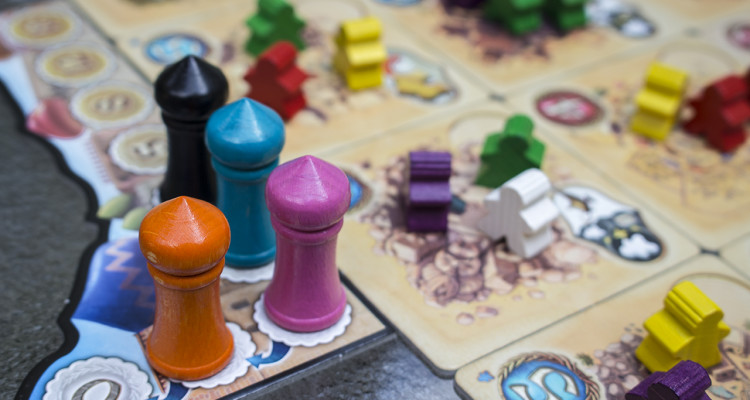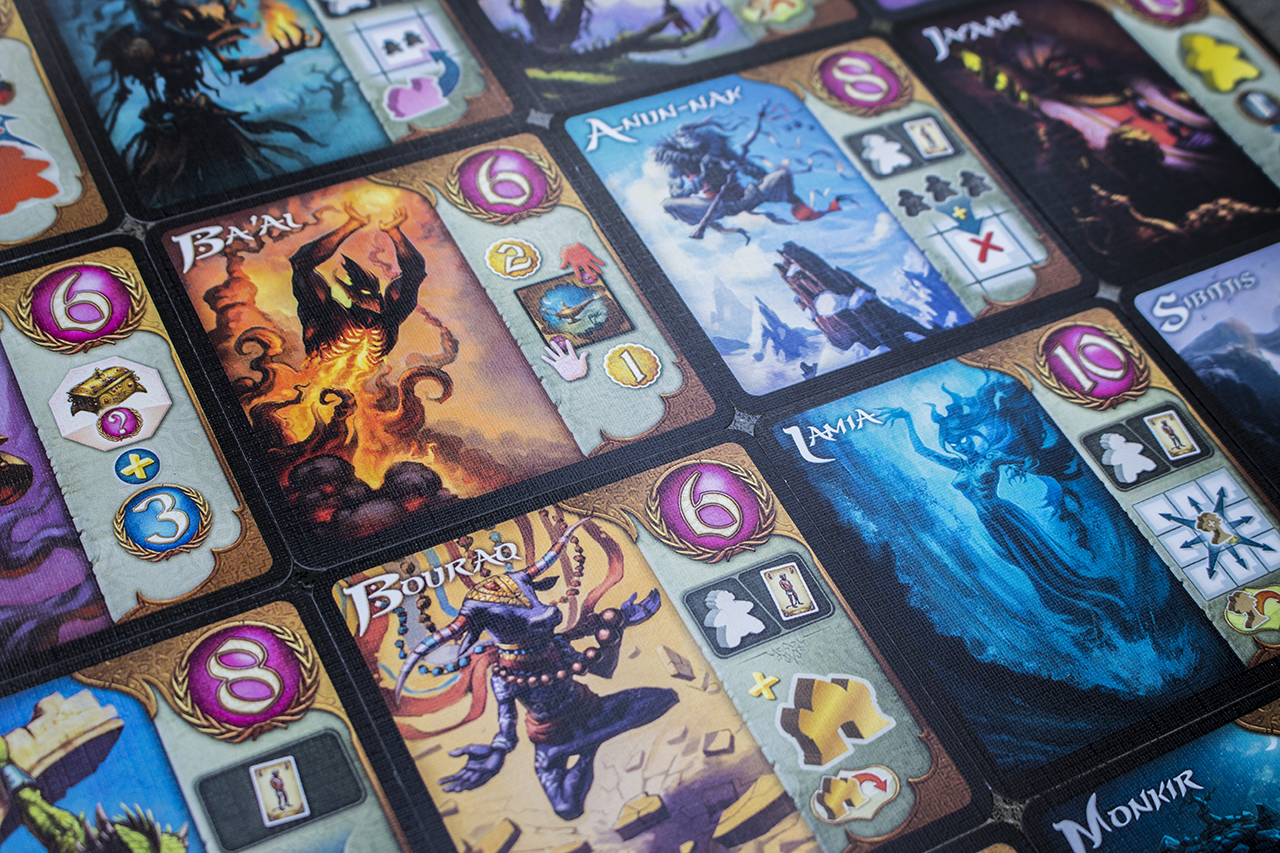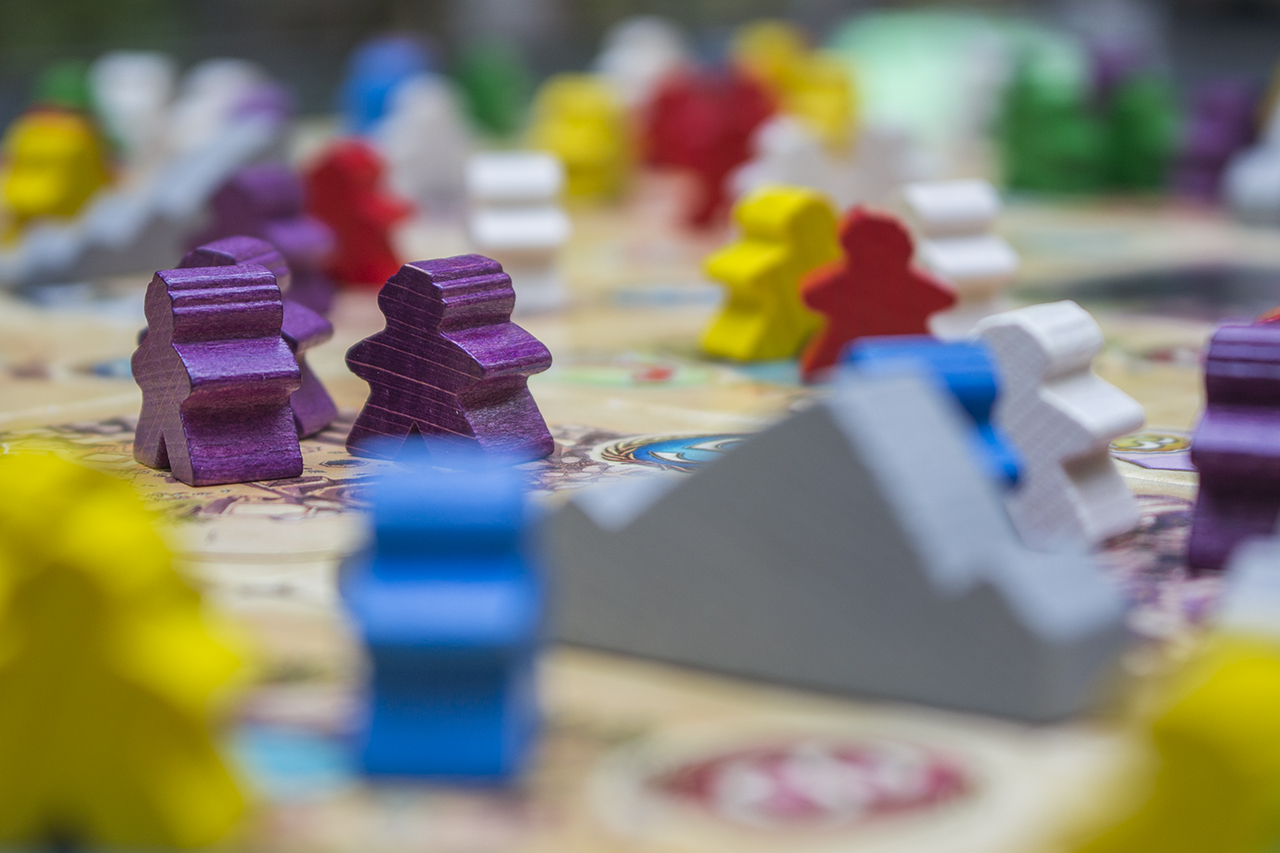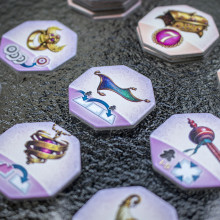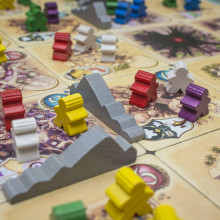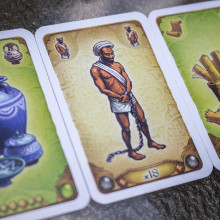Your caravan has arrived at the fabled Sultanate of Naqala, only to find that the city is in turmoil at the death of the old Sultan. All is as expected, except for word that soon comes of others, like yourself, seeking claim to the title. Now, you must struggle with these strangers for control of the city and the support of the Five Tribes. The city’s Viziers may offer their political powers to help you succeed, while striking deals with Merchants and Builders in key locations can also curry needed favor. Persuade the Elders to invoke the power of the Djinns to your cause while heeding tales of deadly Assassins that lurk in the shadows. Your options are as limitless as the desert sands, and so must you find a perfect balance of influence over the tribes if you wish to stake your claim over the Sultanate.
I Like to Pick Things Up and Put Them Down
Five Tribes is a so-called “reverse worker-placement” game set in the land of 1001 Nights, adding another entry to the currently popular set of Arabian-themed games. Featuring a modular board that allows a different experience for each play, it also comes with a metric ton of lovingly produced wooden camels, palaces, palm trees and meeples. The artwork for the game is very appealing and well done, enough so that I would suggest taking a moment to shuffle through the collection of Djinn and admire just how fantastic they look. The setup time can be pretty daunting so be sure to divvy out some tasks to speed up the process.
In your standard worker-placement game, you place your workers (hence the name!) in key locations on the board in order to perform a specific action. In Five Tribes, this will be happening in reverse. Using the Mancala mechanism, players will be moving and depositing different colored meeples around the board, using the last one they place to perform the associated action and also allowing them to activate the power on the final tile.
To take their turn, players pick up all of the meeples from one tile and drop them off, one by one, to other tiles in an orthogonal fashion. The last meeple you drop off must be on a tile that is not empty, and must also already contain at least one meeple of the same color. You then pick up all of the meeples of that color from the tile and perform their action. Each of these tiles offer varying powers that either must, or may be activated at this time. If you end up clearing a tile completely, you get to claim that tile with a camel of your color for end-game scoring. You are now well on your way to creating your delicious point salad, topped with a nice Analysis Paralysis (AP) Vinaigrette.
The tribes, differentiated by meeple color, offer a variety of powers to aid you in your path to victory. You can collect the yellow Viziers, which will individually earn you points plus a larger bonus for any majority you hold over the other players. The white Elders are also collected for end game points, but may be spent to summon powerful Djinns which offer their own special abilities. The green Merchants are available to help you collect various valuables from the marketplace, unique sets of which can be cashed in for increasingly impressive stacks of currency. Strategically used, the blue Builders will also aid in the pursuit of these most precious coins. Or, should you take a darker path, the red Assassins provide the means to remove meeples from the board, potentially opening a tile for your claim. They may even be used to directly strike against an opposing player, killing off a Vizier or Elder that they have swayed to their side. Given all of this, the beauty of the game is that there really is no one single thing you must do in order to win. Multiple paths are available for you to explore in each and every game, and many depend on exploiting advantages as you see them. Success in Five Tribes will ultimately depend on how well you can tactically optimize your chosen moves and the tribes throughout the game. This need for tactical thinking is especially notable when playing with only two players, as each will get to execute two turns per round.
At the start of each turn, players must bid for their place in the upcoming action phase; adding a layer of thought and risk to the transaction, the coins you are putting up are a part of your final score, so do you bid high to insure that one critical move, or hang back and see what your opponents do? You have the ability to bid nothing, but the first person to do so will generally end up going last, so in this stage, the order from the previous turn becomes important as well! The strategy here can start to get tricky as the game progresses and the board options shrink, fostering naturally diminishing returns. If you really want to make a move, the option is available, but you will have to pay for it – that’s the trick. What looks like the best move for you to take may or may not be the best move for your opponent, but how much are you willing to pay to find out?
Throughout the game, you may also find yourself compelling the service of Djinns to your side in order to wreak further havoc upon the board and your opponents. The Djinn cards can be very powerful, and in certain combinations, end up a real force to be reckoned with. A number of Djinns will give you a passive power, while others require additional sacrifices each time you desire their aid. For example, there are Djinns that simply increase the value of your Viziers and Elders at the end of the game, while another may be able to whip up a valuable Palace from thin air, but require an Elder or more as payment. Regardless of whether you are actively pursuing these as part of your strategy, you must always be aware of their presence, especially when under the control of your opponents.
Once your eyes have crossed and there are no more legal moves left on the board, (or an opponent has snuck in and used their last camel to claim the tile you wanted), you may proceed to end game scoring. Thankfully there is a scoring pad provided to assist with the vast amount of available categories. Once everything has been tallied up, the player with the highest score will stake their claim on the Sultanate.
Camels and Palaces and Djinns, Oh My!
No matter your personal feelings, it is hard to deny that Five Tribes offers up a very unique gaming experience. It is easy to teach and relatively accessible to new players, yet still offers up a challenge to the veterans. The ease with which you can initially score points gives the appearance that your path to victory can be comfortably planned, but the reality is more difficult to execute due to the game’s constantly changing variables.
This wealth of options speaks to the potential “paralysis” mentioned earlier. There are simply so many options on any given turn, and the board state shifts so rapidly, that it can be overwhelming to calculate and analyze the impact of each possibility. This combines with, and feeds into, the fact that it is usually tough to pursue just one path to victory. You may see an optimal move while waiting for your turn, but it is often long gone before your next action rolls around. For some, this is the game’s biggest point of contention. Those looking for long term strategy and planning may find that Five Tribes causes your eyes to roll back in exasperation. This game is perfect for anyone looking to adapt on the fly and seize opportunities as they arise regardless if you’ve planned for them or not.
Days of Wonder has brought their standard high production quality to the tiles, meeples and cards in this game. Their foray into a more “advanced” style of play has produced a very accessible game to casual and hardcore gamers alike. The fact that each playthrough is unique, and that there is always a different path to explore makes it a welcome addition to any collection.
Five Six Tribes
At Gencon 2015, an expansion for Five Tribes, The Artisans of Naqala, was released to the charging masses. The expansion adds a sixth tribe (The Artisans), impassible mountains and chasms, as well as even more ways to score points. I’m not even going to mention the six additional tiles that demand even more precious table space! At the start of the game, the purple Artisans are randomly distributed along with their base-game brethren as normal, while the new tiles are semi-randomly set up to form a mountain range of sorts across a portion of the board.
In terms of scoring, the Artisans act similar to the Elders and Viziers in that they can be collected individually for end game points, with a bonus to their value for the player with the majority. The Artisans can also be traded in to receive special magical items on the new tiles, much as Elders could be traded in for Djinns. These magical items can simply offer points during end-game scoring or may allow a player to perform a one-time special action. The flying carpet swoops in during a standard move and allows you to place the last meeple in hand on any other tile on the board, as long as you still adhere to the drop off rules. The enchanted flute allows you to summon up to five meeples from adjacent tiles to a tile of your choice, while the lamp grants you an extra djinn for rubbing it. The deadly scimitar allows you to smite two meeples of your choice, and the rebirth ring allows you to select a magical item from those that have previously been discarded, allowing another use of their powers. Using the talisman lets you move one of your previously-placed camels to an empty tile, snatching that valuable location before anyone else can. Finally, when sounding the horn you may discard the current selection of cards in the market and draw a whole new set.
You are also given one tent meeple that is available for placement on the board. Tents are treated in the same manner as camels, except that they award you an additional point bonus based on the surrounding red tiles (similar to the blue tiles for Builders). This adds another small element to clearing tiles as players race to stake out prime real estate on the board.
The expansion is a nice addition to the game, opening up even more ways to score points without too much hindrance to the already overwhelming array of tactical options. The mountain and chasm tiles require you to find different paths to achieve your goals and limit the accessibility of the powerful magical items. While not overly burdensome, there are still points in the game where you just wish those mountains would move out of your way. The inclusion of more tiles and meeples does increase the potential play time which could be viewed as a negative for a game that is already notorious for being AP prone. After our plays with the expansion, the consensus was that it is a solid addition that seamlessly merges its new mechanics with the base game. Not too surprising, considering that the Artisans were under development at the same time as the main game! Overall, it is a welcome, but not necessary addition. Think of it as adding some croutons, bacon and maybe a little bit more dressing to your points salad.
League Ruling
Steebin
Five Tribes is one of my favorite games and I will never refuse a play. The modular board and random set-up ensure that no two games will be the same which greatly increases the replayability. The artwork on the tiles and djinn cards is also amazing. A majority of my experience with Five Tribes has been with two players which offers a separate experience than the three and four player game.
The bidding for turn order in a two player game has a slightly different strategy in that both players get two moves each round so they are bidding twice for turn order. Successful bidding and timing could potentially lead to consecutive turns allowing you to exploit multiple paths for those satisfying big point turns.
The game seems to be hit or miss with the League, but I suggest that you give it a try and stick it on your shelf!
Smee’s Two Pence
It pays to keep your eyes open in a game of Five Tribes, and you better have put on your pathfinding pants that morning. During the initial few turns, there is quite a lot of information available on the crowded board, and picking out an optimal move without leaving an even better one for your opponents can be quite tricky. The bidding system for player order can be rather interesting for just this reason; it often pays to save your gold and go later in the turn to take advantage of the moves that have been just recently opened up. I’ve seen players out-bid themselves, paying more for their spot in the turn then their action paid off!
As far as the recently-released expansion goes, I’m usually in favor of adding moar stuff!, but adding a sixth tribe to a game named ‘Five Tribes’ just gets my goat. The Artisans of Naqala add even more clutter to a hectic board, and the special powers that their treasures can bestow throws off the expected rhythm of the game. One Thumb
Kelly B
Five Tribes is excellent. I really enjoyed the tactile mechanics of moving the meeples and placing the palm trees and palaces and camels (Oh my!). I can see how it is not a universal favorite – if you’re one for long-term planning, you’re going to be in for some disappointment. I don’t think I would offer this game up as an option if I knew I was playing with some AP prone friends.
The ever-changing board and options for play were really appealing to me, however, when it came to maintaining my interest in play and keeping me thinking throughout the whole game. There is always a new choice! Someone stole the action you wanted to take? They likely opened up a different good one in its place. I also really liked that claiming a tile doesn’t eliminate its ability for other players – if you really want to take the Elder power from a tile but your opponent has claimed that tile, you can still use it and get that Djinn you’re eyeing up!
Overall, the game looks super fun, it’s fast-paced (if you play it that way – stop overthinking all of your moves!) and it’s easy to learn with a lot of options that allow you to continue earning points, even when your opponents steal your moves.
Dan
Let’s first start off by saying that Bruno Cathala is the man! Love or hate his designs, you can never deny that they are innovative and command attention when announced. Five Tribes is no different and I was excited to experience it. After my first play I was very dismissive of the game for its highly tactical and opportunistic play. Not to mention, set-up was a bear! I tend to lean towards more long term planning and strategy so the abundance of options available on the ever-changing board made my head spin. I found myself over-analyzing every single move and countermove, searching for the optimum play. The way the board state can change from player to player with just the small drop of a meeple was frustrating to say the least. The first few turns can be approached with some semblance of a strategy, yet this quickly dissipates as the game goes on and soon divulges into a battle for the best move, which may or may not be sought after by another opponent. However, I was intrigued by the integration of the various point scoring opportunities and the mancala mechanism was also enjoyable. Another positive aspect of the game is the bidding war that’s akin to another one of Cathala’s hits, Cyclades. Figuring out just how much is enough without causing yourself a deficit in the process is an extremely satisfying decision to make.
After repeated plays, I have begun to lessen my focus on the optimum play and take more of a laissez faire approach to the game. That’s not to say that I don’t still analyze available moves, but I have found that in a game where points are scored out the wazoo (yes, that’s a technical term) I don’t always have to worry about every single option that I am leaving my opponents.
I have limited experience with the expansion but from what I have seen, it appears to add breadth but not so much depth. The new mechanics integrate well, however the additional scoring opportunities and play time are something I can certainly live without. That’s not a criticism of the expansion; it plays well, but I am content to play the base game as is.
Overall, Five Tribes is another innovative and well designed game from Mr. Cathala. My issues with the game mainly fall to my preferred style of game as it is still a little too tactical for me to love, but I certainly don’t dislike it.
Buns
Five Tribes has been a polarizing game in our group, inciting many a conversation about the value of tactical gameplay, where skill in games is derived from, and how some people just don’t think through component design (I’m looking at you, Pink Bidding Markers.) While the wealth of conversation has left Five Tribes in League Limbo, there are a few universal truths about this Cathala design.
The first is that Five Tribes is a tactical game. Long term analysis of the board state is nigh impossible and the game will be most agreeable with someone who can take each turn in stride. That doesn’t mean that Five Tribes is devoid of strategic planning – you can definitely adopt a strategy for the game and work toward it; however, you will not have the opportunity to plan its execution beyond a turn or two.
Second, the game is the definition of point salad. Everything you do scores you points, the challenge of the game is optimization. This is where the game falls flat for those more inclined to optimize every move to the fullest. Five Tribes can become boring for those who don’t want to run mathematical scripts in their head each time their turn comes around.
Third, the two-player experience is practically a different game from the other player counts. The simple ability to take two turns per round opens a wealth of strategic options and keeps the game brisk and engaging.
Overall, I really enjoy Five Tribes and have found that the expansion, while simply adding more of the same, doesn’t hinder the gameplay and is a take-it-or-leave-it experience. The game as a whole keeps you consistently in the moment and forces you to watch the board unfold and reorganize between turns. It is by-far at its best with two-players, and 3/4 player games will be smoother and more interesting with your less AP-prone friends. While the game forces and rewards optimization, it just isn’t as fun when players ramp up the downtime. This is a very unique Euro-style game and one that deserves your attention, just not all of it on every turn…

